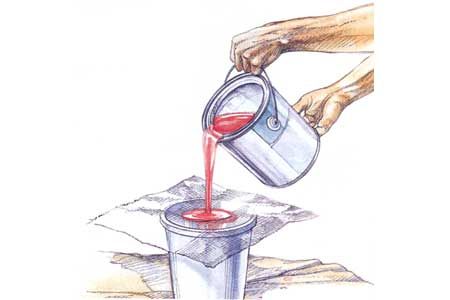Dust, fuzz, and dirt can accumulate in paint cans during storage or transportation, leading to an uneven application and a less-than-perfect finish. Screening paint is the secret to achieving a smooth, professional-looking finish. This often-overlooked process removes tiny impurities that can clog your painting tools and mar the final result. Screen your paint to make a significant difference in the quality of your paint job.
Paint Screening Tools
There are several tools for screening paint, each with its own advantages. Let’s explore the most common options.
Disposable Cone-Shaped Filters
Disposable cone-shaped filters are a popular choice for paint screening. They’re readily available at paint and hardware stores and typically cost about $1 each. They’re designed for one-time use, making them convenient for smaller projects or occasional painters. The conical shape helps funnel the paint, catching impurities as it passes through the filter.
Aluminum Window Screen
A scrap of aluminum window screen is an effective and economical alternative to disposable filters. This option is useful for those who paint frequently, as it can be cleaned and reused multiple times. Aluminum screens are durable and can handle latex and oil-based paints without deteriorating.
Fiberglass Screening
Fiberglass screening is another reusable option for paint filtering. It’s similar to aluminum screening in terms of effectiveness but may be more flexible and easier to work with. Secure it to prevent sagging into the paint bucket.
How To Screen Paint
Screening paint is a straightforward process that can improve your painting results. Follow these steps to screen your paint.
- Before you begin, set up a clean, well-ventilated area for paint screening. Cover your work surface with a drop cloth or newspaper to catch any spills. Gather materials, including your chosen screening tool, a clean bucket, and a stirring stick.
- If you’re using a disposable filter, place it securely over the clean bucket. For aluminum or fiberglass screening, lay it over the bucket and press down slightly in the center to create a shallow depression. This will help guide the paint through the screen. Secure the edges of the screen to the bucket with tape to prevent slipping.
- Slowly pour the paint from its original container through the screening tool and into the clean bucket. Pour steadily to allow the paint to flow through the filter or screen evenly. Stop when the bucket is about half-full to make it easier to work with and to prevent spills.
- Remove reusable screens carefully from the bucket and blot out excess paint with a clean rag. Rinse the screen with water for latex paint or mineral spirits for oil-based paint. Allow the screen to dry completely before storing it for future use.
Benefits of Screening Paint
Screening your paint can lead to a flawless, hassle-free paint job. The main benefit of screening paint is the removal of unwanted particles. This process eliminates dust, dirt, dried paint chips, and other debris that can affect the smoothness of your paint application and the quality of the final finish.
Screened paint flows more smoothly through brushes, rollers, and sprayers. This improved flow leads to better coverage and a more even application, reducing the likelihood of streaks, bubbles, or other imperfections in your painted surface.
By removing impurities, paint screening contributes to a more professional-looking final product. The resulting finish is smoother, more uniform, and less likely to show flaws or inconsistencies once dried.
Common Mistakes To Avoid When Screening Paint
To ensure the best results, be aware of these common pitfalls when screening paint:
- Forgetting to stir the paint: Always mix the paint thoroughly before and after screening for consistent color and texture.
- Neglecting to secure the screen: Ensure the screen is firmly attached to the bucket to prevent sagging or slipping.
- Overfilling the bucket: Keep the paint level at about half the bucket’s capacity for easier handling.
- Rushing the process: Pour the paint slowly to allow proper filtering and prevent overflow.
- Using dirty or damaged screens: Clean reusable screens and inspect for tears or damage before use.
Screening Different Types of Paint
Different types of paint may require slight adjustments to the screening process.
Latex Paint
Water-based latex paints are generally easier to screen and clean up. Rinse your screening tools after use with water. Latex paints may have fewer impurities but can still benefit from screening, especially if they’ve been stored for a while.
Oil-Based Paint
Oil-based paints often contain more particles and may require more careful screening. Use mineral spirits for cleanup and dispose of used solvents properly. Ventilation is crucial when painting a room with oil-based paint.
Specialty Paints
Textured or metallic paints may require special consideration when screening. Follow manufacturer recommendations for these specialty products so you don’t remove important components that contribute to their unique properties.
Professional Tips for Optimal Paint Screening Results
To achieve the best results when screening paint, consider these expert tips:
- Always screen paint, even if it’s new, as manufacturing and transportation can introduce impurities.
- For large projects, consider using a paint strainer bag, which can filter larger quantities of paint more quickly.
- Stir the paint thoroughly before and after screening to ensure even distribution of pigments.
- Use a clean stirring stick to scrape the bottom of the original paint can so you capture any settled particles.
- When working with interior paint, screen in small batches to maintain consistency throughout the project.
Troubleshooting Paint Screening Issues
If you encounter problems while screening paint, like clogged screens or uneven filtering, clear the mesh and reattach it to your paint bucket. If the paint isn’t flowing through the screen easily, it may need thinning according to manufacturer instructions.

